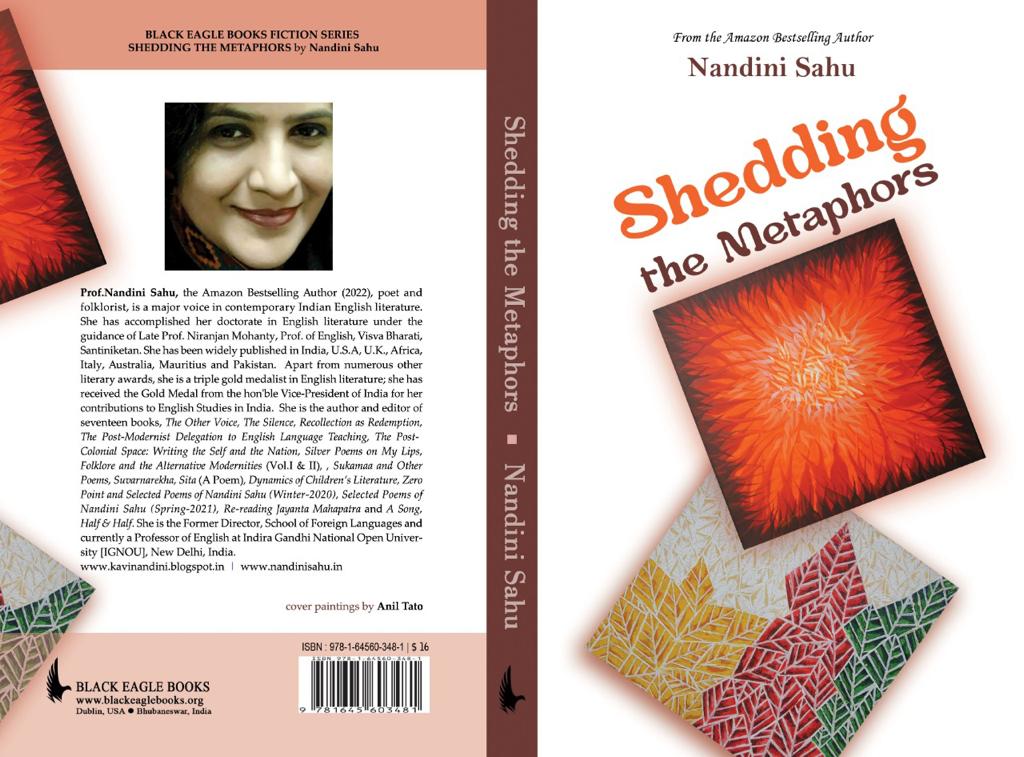


Shedding the Metaphors (A collection of stories by Nandini Sahu) with a total of 160 pages and twelve stories in English came to me as a pleasant surprise from the erudite author who is best known as a poet and folklorist. A beautiful cover by the gifted artist Anil Tato adds to the aesthetic value of the book, I must say. I read almost all the stories at one go, each one in tandem with the other, yet so different in theme and texture, and each story addressing the very important themes– inclusivity and positivity–with an earthly, gender free and multiethnic slant. The stories have an inclination to the theme of ‘letting go’, ‘shedding the metaphors’, and as a teacher of literature, I felt, this seminal book is the need of the hour. The title is indeed intriguing—why should the writer ‘shed’ any kind of metaphor in the first place? Some stories here are finest love stories I have come across; Sahu portrays love as a mystical experience, love that is metaphysical, platonic, ideal, powerful, and all-embracing. Love is God for the writer, it’s the Generator, Operator and Destroyer, that has come to the universe in a feminine form, in the form of her personae. These stories interchange around her ideas of eternal life, of human values, nature and beauty.
Thus, creativity for her becomes therapy to live and sing, in a world that is admirable, yet made obnoxious by some who do not understand aesthetics and higher values of life. ‘The Alternative Masculinity’ is one such story where the protagonist is manipulative. The stories in the collection disclose Sahu’s quest for a better world, a magical world. The ideas of the stories are colossal and kaleidoscopically, mystifyingly alive .Social concern as a theme of literature and the role of the writer as the chronicler of her times, shady, shadowy or otherwise, have occupied centre stage for the better part of the country, and this is the ongoing deliberation for Sahu. Shedding the Metaphors is a key undertaking to the chronicle the events, activities, trends re-counting our times. Her sensible originality is manifested in her use of idioms and thoughts that are entirely her own. Her stories reflect the complex, paradoxically dramatic inner lives of modern men, women and the LGBTQA. ‘Shadow of a Shadow’ is a breath-taking tale of layered female bonding. Sometimes Sahu seems dazed by the enormity of the possibilities in life; perhaps she should guard her pen against it! The story-teller Sahu, who writes poeticprose even in her stories, has an unquenchable desire to live and experience life, rejecting self-imposed isolation. She is delicate, complex, capable of experiencing a rich range of emotions, but perpetually tender, caring and reflective. Her autobiographical stories reveal her personality.
Sahu reflects on the state of the contemporary world with its burning issues— her creativity is boundless like the writer herself, thus deliberately marking the continuity with a generation of Indian women writers. In this collection, each story is refreshingly diverse, and words have been used with great potential. In a retro of political uncertainty and changing social values, Sahu attempts to play the role of the harbinger of communal harmony in stories like ‘The Wild Stream’. I found a very soothing story in the book, ‘Being God’s Wife’, where she talks of family ties, of love that creates a bond, while giving space to the personae to foster; and she realizes that writing this story has been a purging experience for her.
Sahu’s prose is lucid, candid, precise, earnest and original without any hyperbole, hypocrisy. She is a writer of overflowing words, but honest ones. Her tone is conversational, voice is vibrant and unswerving. Courage, conviction are the hallmarks of her stories. Hertry-outsare a queer faminine sensibility, but at the same time Sahu looks at life from humanitarian point of view. These stories undeniably play around complex human emotions, they linger in the heart even much after reading them. I would like to conclude by quoting Sahu from the Preface, “My bigger concern, when I write stories, is the symbolic and the symbiotic connections between unworldliness, religion, theology, art, and more obviously, similar connections between language and literature that strive to interiorize men, women and nature. The symbolic connections between human and non-human play a rare enough role to show the greatest importance of time, place and people. Thus, it is apt to read carefully my stories of feminine adept, and understand how I feminize nature and naturalize women. It is my empirical and experiential connection, which scrutinizes age, sex, race, class and colour to shelter the naked empirical evidences—talking about subjugation of women and nature as well as mental health of men and women and the jeopardy thereof. The characters, major or minor, ever created by me, fall sick, fall in love, have mood swings like Nature, suffer both physically and psychologically or accept death without fuss. Certain others encounter difficult situations; however, it is dangerous and rackful because they have already waged a war against iniquitousness in human civilization. They live an unannounced, unconventional Renaissance.
Dr Manisha Nigam Sinha is an Assistant Professor of English in Amity University, Noida. Her research interests are ELT, Linguistics and New Literature